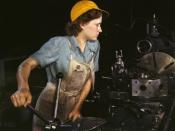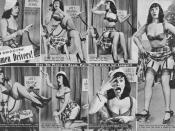"Okay Mrs. Leeper, just one more pushâ¦Give it all you've got nowâ¦Alright, here it comesâ¦It's a⦠It's a girl!! Oh, she's a beautiful baby girl!" Let's stop and think about what just happened. A brand new baby has just been brought into this world and already she has been labeled. That's right; she's been labeled as a 'girl'. If you are female, you're probably wondering, "What's so bad about being a girl?" Well, it's not that being female (or male) is bad. It's just that as a society, we tend to view boys and girls as having different expectations or gender labels. By this I mean that we give boys and girls different stereotypes and guidelines that they 'should' follow or fulfill according to which sex they are. For example, a very common stereotype is that males are thought to be the physically stronger sex, whereas women are considered to be weaker and more delicate.
Did you know that gender stereotyping begins right from the moment a child is born? We either categorize babies as being 'pretty' if they are female or as handsome if they are male. Gender stereotyping is so common amongst us that we don't even realize that we are doing it. Even the clothes that babies are dressed in tend to send out stereotypical messages. Often the first impression is that the child wearing blue must be a little boy, while the child in pink would obviously be a little girl.
I feel that by stereotyping males and females society is decreasing our opportunities to let us be who or what we would truly like to be. Obviously there are people that don't care what others think of them, but there are others, especially young people, who want nothing more than to fit into what society considers 'normal'. It is often said "Don't judge a book by its cover", and the same should go for people. It would be unfair to judge a human being by gender. Doing so places unfair limitations, unrealistic images and unnecessary pressure on people to fit into what society considers 'normal.' In this paper I will discuss how media and children's toys are used to reinforce gender stereotyping in North America today.
The methods used in the fieldwork of this report are through researching various books and Internet sites. I constructed a survey consisting of one hundred high school students in the Catholic school. Surveys where handed out to ten females and ten males in each of the five grades. The survey outlined eleven questions pertaining to gender roles and what influence this subject has had on their lives. A few limitations I have come across while doing my research is the lack of knowledge I have on analyzing and interpreting facts. There is also a time limit in which this report must be completed. When reviewing my surveys it was brought to my attention that some surveys where not completed to the level of seriousness that I had expected. However, from the information that I have gathered I will attempt to prove that media, toys, and magazines are weakening the chances for us to break through the gender stereotypes we have formed over thousands of years.
It is generally accepted that women are considered 'homemakers' while men are considered to be 'bread makers' (the ones that do the work and earn the money). Statistics of Canada shows that there are two million more women than men who are not included in the Canadian labour force. (Snell Perry, 1998). This means that there are two million more men than there are women employed in Canada. Although women have the option of returning to work after giving birth, or working while raising children, there is still an expectation in society that women should consider being stay at home moms. It is difficult to raise a family these days with only one income because the expenses associated with having children are so high. That is why most families today have both parental figures in the workforce, even if one parent is only employed part time. (Stern, 1989) However, the fact that there are so many more men than women employed in Canada leads to evidence of the existence of gender stereotypes. After all, if Mom goes back to work, who will take responsibility for all of the duties typically assigned to the wife and mother stereotype? (i.e.: cooking, laundry, child raising.) There is still a negative stigma attached to the idea of mothers returning to the work force. Perhaps by being out of the home environment, the health and welfare of the children will suffer. According to Lois Hoffman, a psychologist from the University of Michigan, she found that after reviewing 50 years of research, the negative effects of maternal employment never materialized. Her research showed that "most often, children of employed and unemployed mothers didn't differ on measures of child development. But children of both sexes with working mothers have a less sex-stereotyped view of the world because fathers in two-income families tend to do more child care'. (Roslind C. Barnett, 1992).
One must consider the origins of gender stereotyping and how certain beliefs became acceptable. Think about pioneer life, and how society must have functioned then. Most jobs back then were physically demanding. Farming, mining, carpentry, blacksmithing, fishing and hunting were all necessary for survival. These demanding jobs were done by men, while women in the pioneer days were very domesticated. The laundry, cooking, sewing, general cleaning duties and child raising were done by women. In pioneer life this model of societal behaviour functioned well. (Anthony Layng, 1993). However, is this still an ideal model of gender roles in today's society? Life is much more hectic and complicated now than the simple days of pioneer life. Technology is very advanced now, making many jobs much less physically demanding. There are also more jobs available now, and job requirements have changed also. It is now possible for us to fulfill almost any job we desire, as long as we are qualified, regardless of the gender that we were born into. Considering that, why are there still less women employed in the Canadian work force, and more women than men still at home fulfilling the stereotype of being 'homemakers'? Ideas about gender roles are formed very early in life. From the clothes that children are dressed in, to the toys that children play with, gender stereotypes are reinforced almost every day. Even in the movies and books that children are exposed to, there are messages of stereotypical gender expectations. (Weinraub, pg. 33) Imagine having to buy a gift for a small child's birthday. Entering the toy department, the first thing you will notice is that the toys are divided into a section for little girls, and one for little boys. The difference between the two sections is that "toys for girls encourage domesticity while boys receive not only more categories of toys but ones which are more complex, more expensive, and suggest activities that are not homebound". (Linda Lindsey, 1990). In the section of girls' toys, there are various dolls, doll accessories, dress up clothes and play make up kits. There are also little ovens, ice cream makers, bead kits and sewing kits. In the boys' section of toys, one will be able to find trucks, cars, spaceships, robots and tool kits. There are more mechanical toys for little boys and more pretend guns or flying toys. Dress-up clothes for young males include fireman hats, police hats and badges and cowboy clothes. For young girls, the dress-up clothes include high heels, false nails, tiaras and feather boas. Already the gender stereotype is being strongly reinforced, as parents buy these toys for their children. (Lindsey, pg. 77).
Even toys that appeal to both genders have been marketed to either one gender or the other. (Basow, 1997). For example, Lego is a popular toy. Building things out of joining blocks is fun and imaginative. When buying Lego however, one will notice that it comes in different colours. Pink, yellow and pastel green Lego comes in a box with a picture of a pretty Lego house or flowers. Red, dark green and blue Lego has pictures of cars or planes on the box. (Basow, pg. 46). Would a little boy be happy opening the box that was marketed specifically to a girl his age? Would a little girl be as excited about a wrestling figure as she would be about a Barbie doll? Probably not, especially when products are being marketed in ways that lead children to believe that 'certain genders want certain toys.' (Rose Lewontin, 1990) If a girl asked for tool belts and trucks and cars, and engaged in other 'male' play activities, she would be considered a tomboy. This is the label given to her to explain why she does not fit into the expectations that society has placed on her. If a boy were to ask for feather boas and play ovens and fashion dolls, he would be labeled a sissy, another label used to explain the child's 'odd' behaviour. Neither of these labels are considered positive, and the child might pick up on the disapproving tone in which it is used. (Kaye Stearman 1995). If a child believes that his or her toy or play choices are not approved of, will he or she continue on with that behaviour? Probably not, and instead the child will try to make choices based on what society will approve of, such as picking the stereotypically accepted toy.
It is a well known fact that media has a large and very important influence on our society. The messages relayed in television, movies, magazines, newspapers and advertisements reach all across North American society. (Lois Smith, 1994). Media is a powerful force that is difficult to ignore. Does the media reinforce gender stereotyping in young children? Of course it does, even if we are unaware that it is happening.
From a very young age, children are exposed to fairy tales, either through books or popular movies. One might ask, "What's wrong with fairy tales?" After all, these stories are full of imagination and good morals. Some of these stories teach us the consequences of lying, running away, and disobeying rules. (Lois Smith, pg. 32). But that is not all that these stories teach young children. In this report, the focus is mainly on Disney movies, because Disney is the world's largest marketer of children's movies, and often these movies are not appropriate for the young age groups that they are marketed towards.
In the Disney versions of Snow White, Cinderella and Sleeping Beauty, the main character finds herself in a troublesome situation. However, instead of taking action to change things, all three of these characters waited for their Prince Charming to come and save them. (Nikki VanderGaag, 1996) This could be interpreted as relaying a message that all a woman needs is a good man to take care of her. This is a message that in reinforced again in The Little Mermaid. In fact, when the Little Mermaid goes to the Sea Witch, Ursula, for help she is told that her voice is unimportant. The lyrics of the song that Ursula sings to Ariel include the following lines: "The men up there don't like a lot of blabber They think a girl who gossips is a bore Yes, on land it's much preferred for ladies not to say a word And after all, dear what is idle pratter for? Come on, they're not all that impressed with conversation True gentlemen avoid it when they can But they dote and swoon and fawn on a lady who's withdrawn It's she who holds her tongue who gets her man." (Jodie Beson) After having this explained to her, does Ariel choose to keep her voice and woo the Prince another way? Unfortunately, Ariel agrees to trade her voice for a pair of legs, and depends on her beauty, not her mind to find true love. Is this a healthy message to be sending out to today's youth? That physical beauty is more important than anything else a person could offer? The messages Disney relays are not much more promising for young boys. In Beauty and the Beast, there is a lengthy song glorifying Gaston, the town's hero figure. In the lyrics of this song, Gaston's large physique, his violent temper and his poor manners are all praised and admired by the town folk. The film also reinforces stereotypes for young boys in the character of the Beast. The Beast is portrayed as an angry male with a violent temper. In several scenes he yells loudly at Belle and towers over her, using his physical size and strength to intimidate her. He is also seen destroying objects, throwing things and fighting quite violently with Gaston to keep him away from Belle. (Anti-Disney) In many ways, the Beast displays many signs of an abusive man. However, in the end, he still manages to win her love. Through these types of movies there are inappropriate message being relayed to young, defenseless children. Especially with in the younger children, it is sometimes difficult for them to understand right from wrong. Yet, by allowing them to watch movies such as theses society is sending out the message that these behaviours are acceptable.
As a society, we tend to put little thought into the negative messages that are put into these movies. Children are often very excited to see these films, especially because the advertisements are targeted towards young children. Fast food stores offer small action figures from these movies and the toy stores fill their shelves with Disney related products. Linda L. Lindsey writes, "The research is conclusive that children's television is generally sexist and gender stereotyped". (Lindsey, pg.79). However, on a daily basis very little consideration is given to how something as simple as fairy tales and children's movies further stereotype and limit our growth as a society.
Even commercials can be damaging when discussing gender stereotyping and the effect it can have on children, as "commercials are blatant in creating desires for toys encouraging domesticity in girls and high activity in boys". (Tim Unsworth 1993). Children's television is heavily supported by commercials targeted at children, such as advertisements for toys. "Advertisers orient children to the idea that products are waiting to be bought at local stores and that to do without them is an unfortunate hardship."(Tim Unsworth, pg.80). This message creates pressure on parents to buy products that children 'must' have right away. Often times, parents will search high and low for the newest toy on the market, and will pay ridiculous amounts if the toy is found so that their child will not feel left out on the playground.
Although gender stereotypes are introduced right from birth, they are reinforced throughout a person's lifetime. All over North American culture, the ideal roles for men and women are emphasized again and again. Although society has progressed greatly in gender equality since the days of the pioneer, the stereotypes still exist and continue to slow any further progress that may be achieved.
Magazines are also specifically targeted to one gender or another. Teen magazines aimed towards teenage girls are filled with make-up tips, dating tips and advice on attracting the opposite sex. This is a trend that carries on into later life. Magazines targeted at women include decorating, housekeeping and parenting magazines, while men's magazines include mechanical content, sports issues and many more pictures of beautiful women in minimal clothing. (C.Estelle Campenni, 1996). At all stages of life, the media further reinforces gender stereotyping. After all, maybe men would decorate more beautiful cakes and create stunning flower arrangements if there were helpful tips listed in their issue of Sports Illustrated or Maxim.
Gender stereotyping also leads to many double standards in society. For example, it is often more acceptable for males to have sex before marriage than it is for females. Men who have had several sexual partners are often considered 'studs', while women who have had several partners are considered 'dirty' or 'sluts'. (Priscilla Painton, 1993) These unfair double standards can affect self-esteem in a very negative way for women. After all, no one wants to be labeled in a disapproving way. For men however, the positive label of being sexually experienced might make one strive for even more partners. This is not actually a good idea in an age where sexually transmitted diseases are so common and deadly. Also, by being promiscuous, it might be harder to find true love, especially if the main focus is being placed on physical pleasure.
The affects that gender stereotyping has on society is beyond measure. Gender stereotypes help create an identity yet, it also limits one to the expectations attached to that gender. Fairy tales were written during a time period in which gender roles were accepted. In today's society, there is no longer a need for 'roles' because society functions differently now then it did many years ago. By continuing to expose young children to these negative messages, society is slowing down any further progress in gender equality.
The Methods used in the fieldwork conducted for this research paper were surveys. This method seemed most logical due to the amount of time given, the amount of research needed to be discovered and easiest way to get a general idea of the affect gender stereotyping has had on society. One hundred students from St. Josephs High School in Barrie were asked to complete a survey outlining eleven questions pertaining to gender roles and the affect of this matter on their lives. Ten females and ten males were selected out of the following grades: 9, 10, 11, 12 and OAC. For each of the following questions asked, the percentage was calculated according to gender.
As a young child there is generally two categories of toys to play with: Barbie's and Dolls for the girls, and Trucks and Action figures for the boys. Out of the 50 males that took this survey 98% of them played with trucks and action figures while the other 2% played with the other group of toys. Out of the 50 females that took this survey, 92% played with Barbie's and dolls while the other 8% played with trucks and action figures.
When born, one is either dressed in pink if they are female and blue if they are male. According to this over the years, what colour did the females and males prefer? Out of the 50 males, 96% chose blue as their preferred colour while only 66% of females chose pink as their preferred colour.
Society has developed words that are generally used or aimed at a specific gender. An example would be the word "beautiful". Out of the 50 males asked, 84% said that women are generally referred to as being "beautiful". Where as out of the 50 females asked, 100% of them said that women are generally referred to as being beautiful.
It is often a bit of a debate whether or not it is considered socially acceptable for a male to cry. 16% of males said it was acceptable while the other 84% of males disagree. Only 12% of the females said it is socially acceptable for males to cry while 88% say it is not.
It is generally known that females are more sensitive and emotionally attached in relationships. Out of the 50 males, 92% of them agree with this. Out of the 50 females that completed this survey, 98% of them agree with statement.
Males are usually seen more in a High rank or Management position. 96% of the males believe that this statement is true. While out of the 50 females asked to complete this survey, only 94% of the females believe this is true.
The question was asked if one thought rough sports were only intended for males, females or both. Out of the 50 males, 66% thought that rough sports were only intended for males. While another 30% of males thought the sports were intended for both genders. Out of the 50 females, 56% believe that the sports were intended for just males. And the other 40% said that these rough sports are intended for both genders.
Between the ages of 15 through 18, which gender is more sexually active? Out of the 50 males surveyed, 88% of them said males were more sexually active with in that age block. Out of the 50 females surveyed, 86% of them believe that males are more sexually active then the females.
It is generally known that females are more nurturing and understanding. Out of the 50 males, 94% of them agree with this statement. Out of the 50 females surveyed, 100% of them agree with this statement as well.
Males are thought to generally be more aggressive and competitive. Out of the 50 males that conducted this survey, 96% of them agree. And out of the 50 females that conducted this survey, 98% of them agree.
Generally females are stronger in the subject of English and males are stronger in the subjects of Math and Sciences. Out of the 50 males the completed this survey, 58% believes this statement is true while the other 38% believes it to be false. Out of the 50 females that completed this survey, 68% believe this statement to be true while the other 32% believe it to be false.
A methodological problem I came across while conducting my surveys was that a few were not totally completed. There were a couple survey questions left blank or there were two answers circled.
While constructing my surveys, I narrowed down four questions that I believe really target towards an individual on how gender stereotypes have influenced their lives. I decided to discuss these four questions and put my thoughts into why I believe these questions have an important relevance to how we stereotype genders.
The first question that I believe is rather important is what types of toys a girl or boy played with as a child. The amount of males that played with trucks and action figures was 98%. The amount of females that played with Barbie's and dolls was 92%. In all, I am not surprised at the outcome of these figures. From day one, we are given guidelines as to what we 'should' and 'should not' play with depending on what gender we are. As little girls we are often exposed to dolls that we refer to as "our babies" like we are to our mothers. Mothers are usually their daughter's role models; therefore young girls want to assume the role their mom has. The same goes for young boys. They often see their fathers driving big trucks and using tools to fix things. They want to be like their dad in a sense of pretending to 'do what they do'.
The second question I would like to discuss is if it is, or isn't, socially acceptable for a male to cry. Surprisingly, 16% of males said it was acceptable for them to cry, while only 12% of females said it was acceptable. Another way to interpret this would be 84% of males believe its not acceptable and 88% of females believe its not acceptable. I was shocked to see that more males then females believe it's acceptable for a male to cry. The reason why is because females are thought to be more understanding and sensitive to such areas. Most males don't cry because they are afraid of being made fun of and loosing their reputation as a 'tough guy'. Perhaps from the outcome of these surveys males are beginning to realize that it is okay for them to express their emotions because, like females, they are human too.
The third question I would like to discuss is whether or not rough sports like football and ruby are generally intended for males, females or both genders. It turned out that there wasn't a drastic difference between what the males thought and what the females thought. The amount of males that believe rough sports are only intended for males was 66% while the other 30% of males believe rough sports are intended for both genders. On the other hand, 56% of females believe that these sports are only intended for males while 40% believe that these sports are meant for both. In the major leagues, professional male sports are more publicized leading us to believe that males are the only ones to qualify to play the sport. Also if a woman endures in a rough 'male type' sport, she is considered 'tomboy' like. It's a positive sign to see that a quantity of males and females believe that both genders are eligible to participate in such sports that are strongly aimed towards the male gender.
The final question I would like to discuss is between the ages of 15-18 which gender is more sexually active. The results to this question were very close between the genders. The amount of males that believe they are more sexually active in this age block were 88%. Which only left 12% of males to believe females were more sexually active during that age. From the females, 86% believe that males are more sexually active and only 14% thought that they were more sexually active with in this age period. Many females tend not to be as sexually active as males due to the 'label' they are given. If a woman is very promiscuous, she is often labeled as a 'slut' or 'whore'. However, males are often glorified for the number of women they have slept with and are seen as 'macho' and 'wanted' by all the ladies.
I believe through these surveys it is relevant to see that gender stereotyping is still evident in today's society. As young child, I wish I had been more educated on gender stereotyping. That way I'd be aware of the complications out there concerning those that don't fall into the societal guidelines of a 'delicate female' and 'tough male'.
Through out my research findings I have become quite aware of the matters in which young children, teenagers and adults face due to gender stereotyping. It starts from day one at birth and carries on with you through the years. Gender stereotyping plays such a major role in our lives that we don't even realize we have these 'restrictions' set upon us. Stereotyping males and females and setting invisible guidelines on each gender is decreasing our opportunities to letting us grow was individuals. It is contradicting our right to freedom and independence from each other.
I believe that stereotypes are true differences that are exaggerated between genders. What I mean by this is that there are obvious differences between females and males. One of them is the factor of strength. It is generally known that men are physically bigger and stronger that most women. So, because of this, we have automatically assumed that ALL men are stronger then ALL women. Yes men are stronger physically but we have exaggerated it to the point that if you're male, you're strong and if you're female, you're weak.
There is also the stereotype of "men don't cry". We all know that men do have emotions, just like females because they are human too. Females are known to be more emotional then males and are known to express their emotions more dramatically then a male would. Males are very capable of crying, it's just that they don't cry as easily as females do. So in all, we have an understanding that men don't cry as easily as women and exaggerated it into a stereotype of "Men don't cry".
I feel that my hypothesis of gender stereotypes was supported by my findings through research and the surveys. It was a positive research outcome that provided me with the information I was searching for to get a complete understanding. I feel that we as a society have come along way reflecting on gender stereotypesâ¦but we can't stop here. We must continue to educate young children about stereotypes and make them aware of what its like in the real world. That way, perhaps by the time they are old enough to go out on their own, they'll have started an understanding that everyone has a 100% chance to do whatever they want in life. Even if it means doing something out of the 'norm' of what society expects. Before I conclude this paper, I would like to leave you with a quote that I came across while doing my research. "Stereotypes should apply in general but not to an individual. They should serve to help make judgment but not as an absolute." (Kirchner, 1974). In other words, you can acknowledge that there are stereotypes among us but don't let it confide you into being someone that you're not. Do not let it affect you as an individual because like every snowflakeâ¦we're all different in our own unique way!





